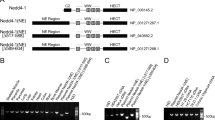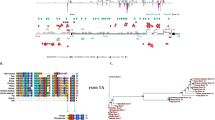Abstract
We previously isolated and characterized cDNA clones of DRT (EPHB2), encoding a receptor protein-tyrosine kinase of the EPH family. Northern blot analysis showed that EPHB2 transcripts are expressed in three sizes of approximately 4, 5, and 11 kb, suggesting that these transcripts are generated by alternative splicing and/or alternative use of polyadenylation sites. To explore this possibility, we isolated additional EPHB2 cDNA clones, including clone 5K-1, by re-screening the human fetal brain cDNA library. Nucleotide sequence analysis of clone 5K-1 revealed that it represents a variant transcript of EPHB2 (EPHB2v). Relative to the EPHB2 cDNA sequence previously reported, clone 5K-1 has two coding region deletions of 3 and 93 nucleotides. Nucleotide sequence analyses of EPHB2 genomic DNA fragments corresponding to these deletions suggest that the EPHB2v transcript is generated by alternative splicing. The 3′ end of clone 5K-1 contains a polyadenosine stretch preceded by a potential polyadenylation signal, which is not used to generate the EPHB2 transcript. Taken together, these data indicate that EPHB2v is generated by both alternative splicing and alternative use of polyadenylation sites. The EPHB2v protein lacks one arginine residue that resides immediately following the EPHB2 transmembrane domain. In contrast, as a result of the frame shift caused by the 93 nucleotide deletion, the C-terminus of the EPHB2v protein is longer by 70 amino acids than that of EPHB2. We also show that the human neuroblastoma cell line SY5Y and NTera-2N neurons express high levels of EPHB2 and lower levels of EPHB2v. These structural variations found between the EPHB2 and EPHB2v proteins may reflect functional heterogeneity of EPHB2.
This is a preview of subscription content, access via your institution
Access options
Subscribe to this journal
Receive 50 print issues and online access
$259.00 per year
only $5.18 per issue
Buy this article
- Purchase on Springer Link
- Instant access to full article PDF
Prices may be subject to local taxes which are calculated during checkout
Similar content being viewed by others
Author information
Authors and Affiliations
Rights and permissions
About this article
Cite this article
Tang, X., Pleasure, D., Brodeur, G. et al. A variant transcript encoding an isoform of the human protein tyrosine kinase EPHB2 is generated by alternative splicing and alternative use of polyadenylation signals. Oncogene 17, 521–526 (1998). https://doi.org/10.1038/sj.onc.1201960
Received:
Revised:
Accepted:
Published:
Issue Date:
DOI: https://doi.org/10.1038/sj.onc.1201960



